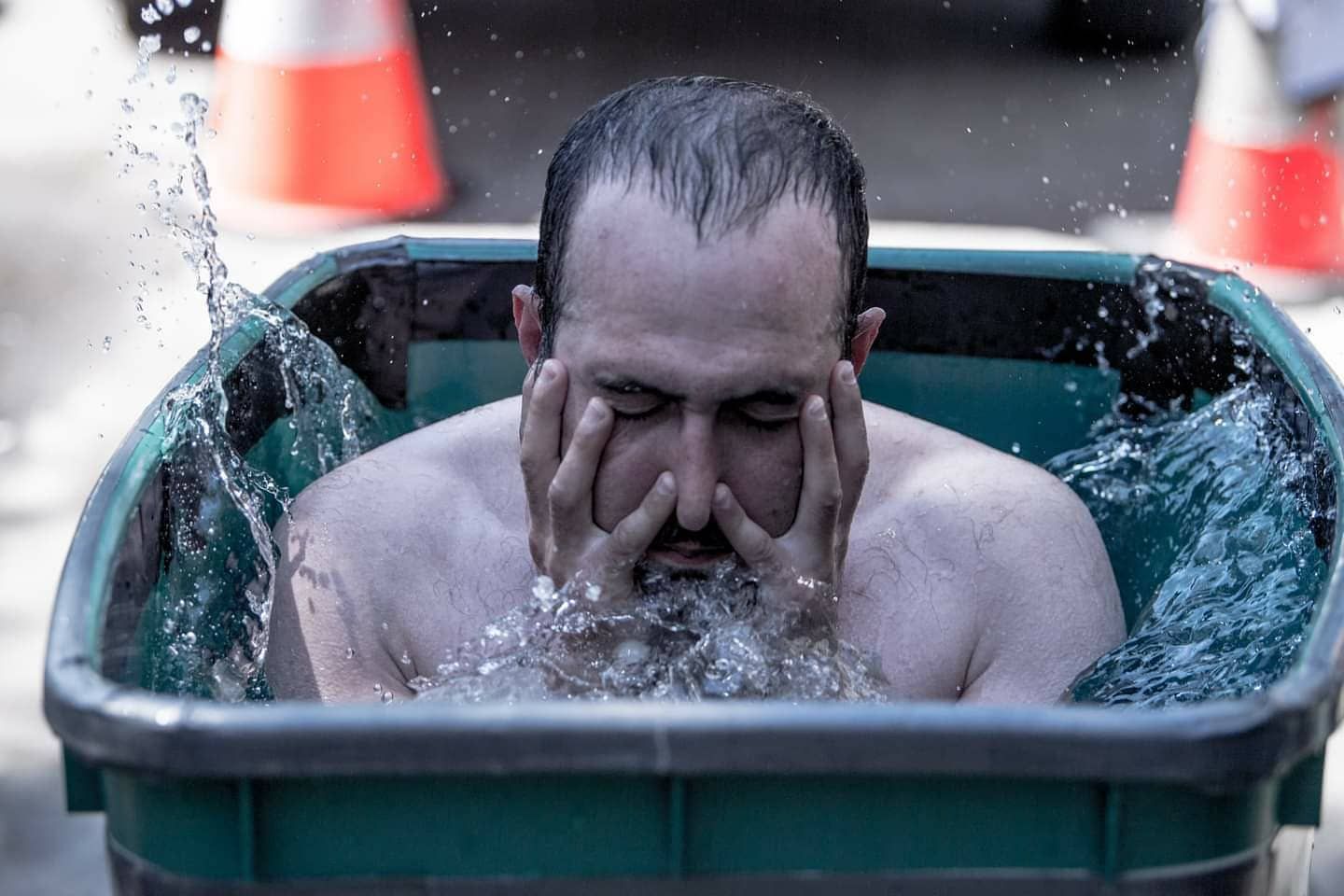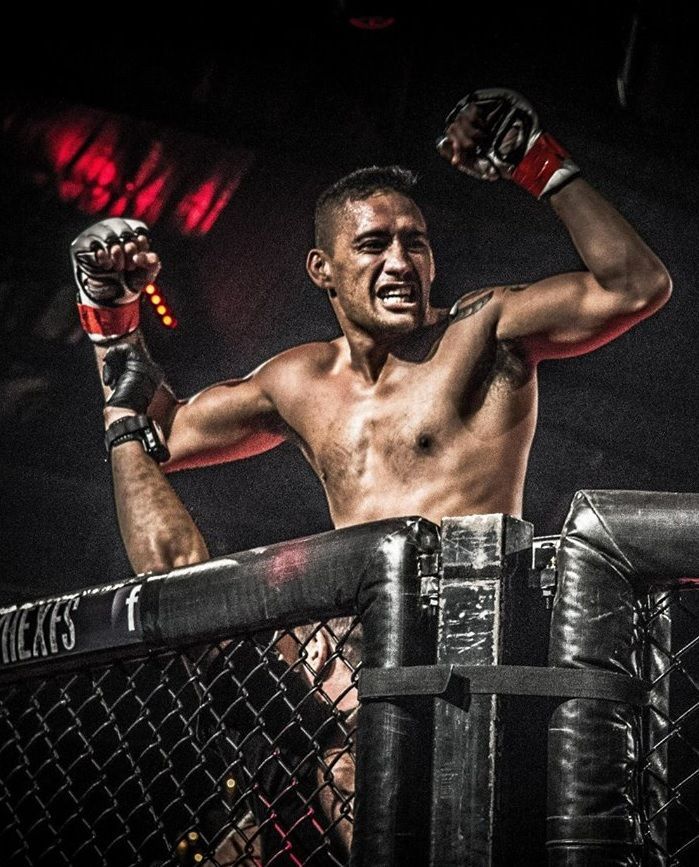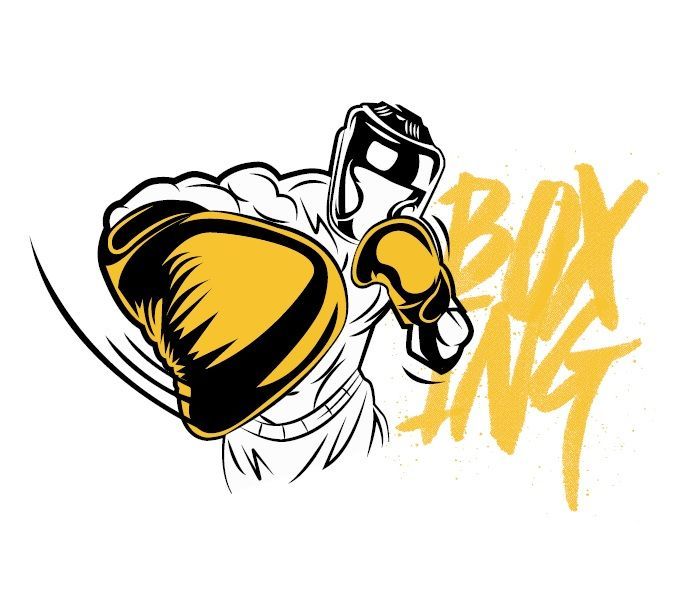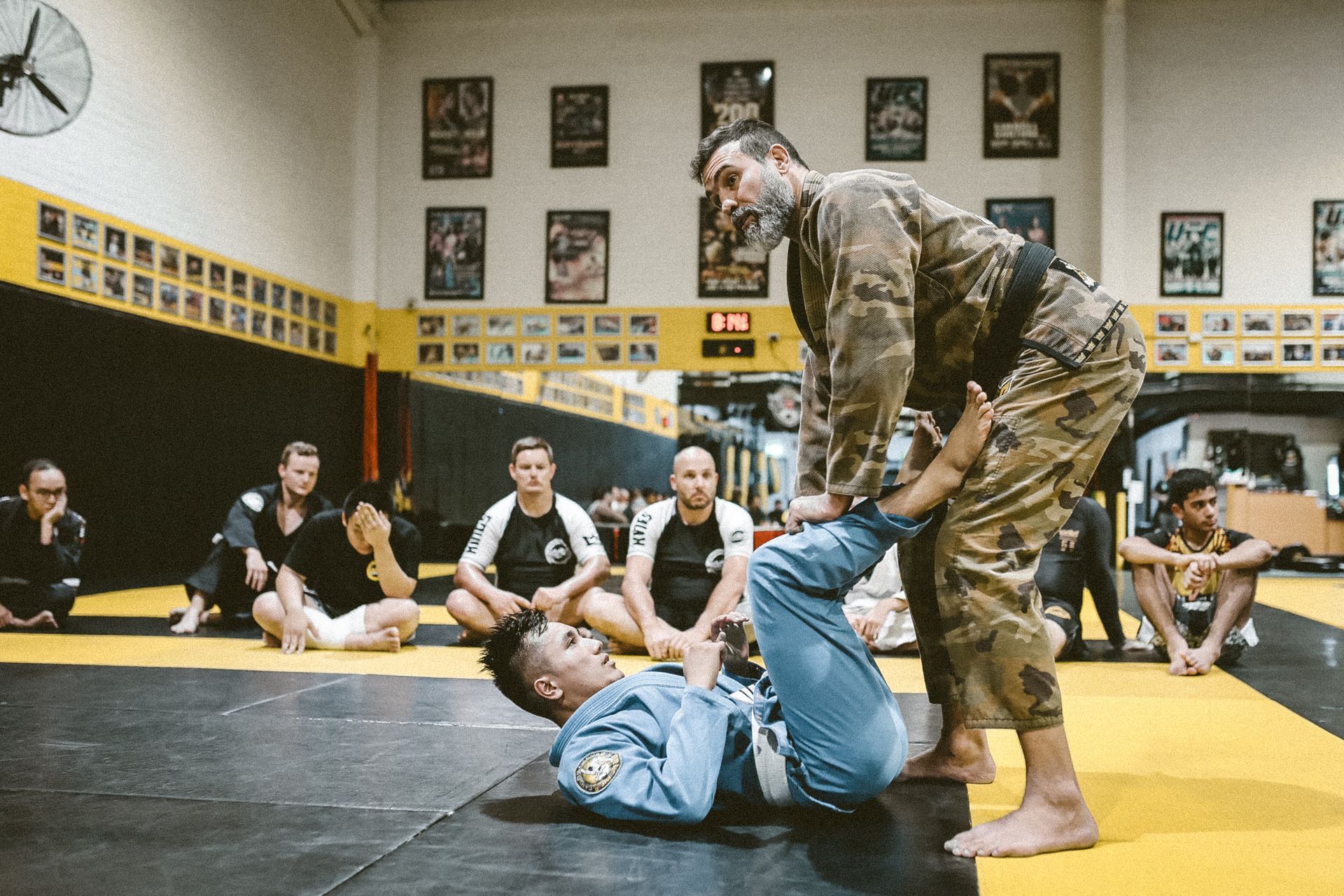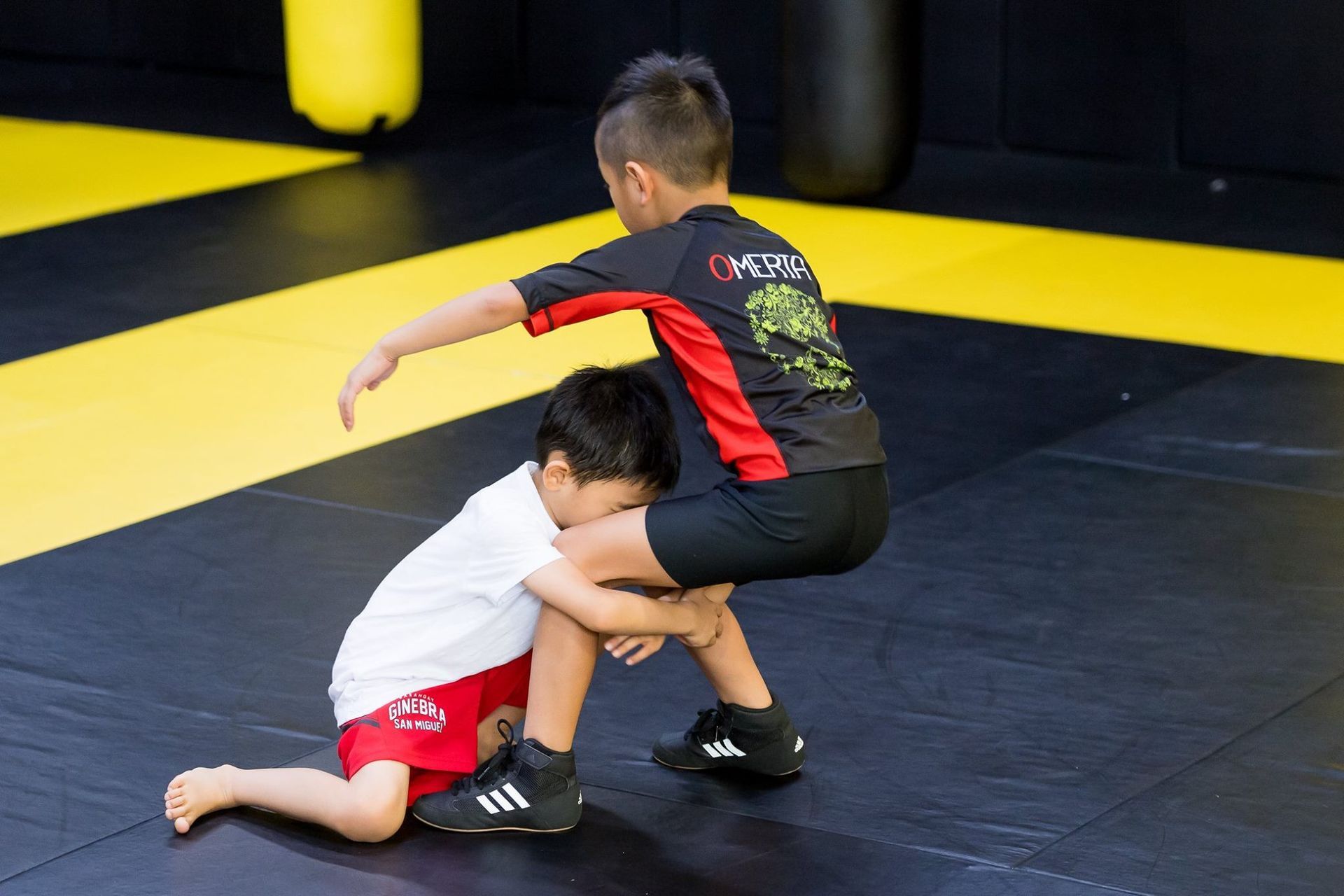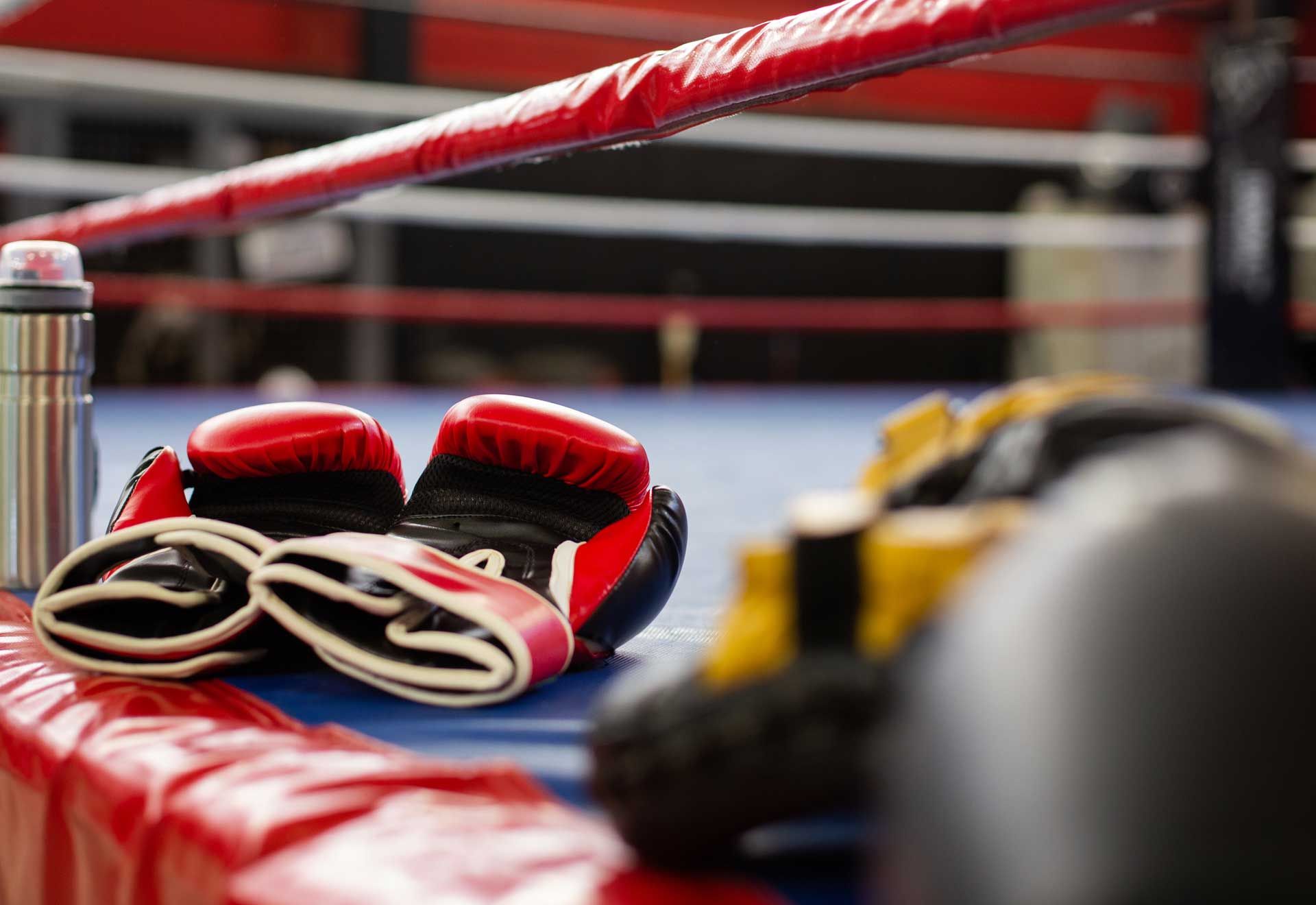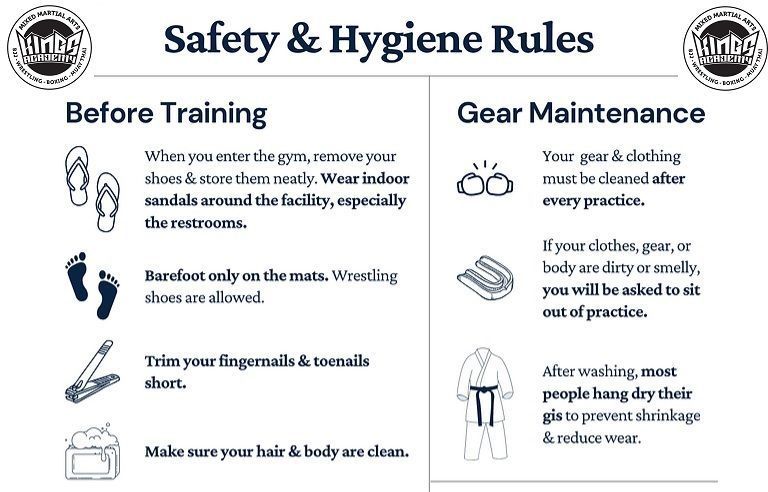Learn about Brazilian Jiu Jitsu (BJJ)
Learn all about Brazilian Jiu Jitsu (BJJ), where the sport came from, what's involved, what are the benefits, and who are those that moulded the art into what it is today.
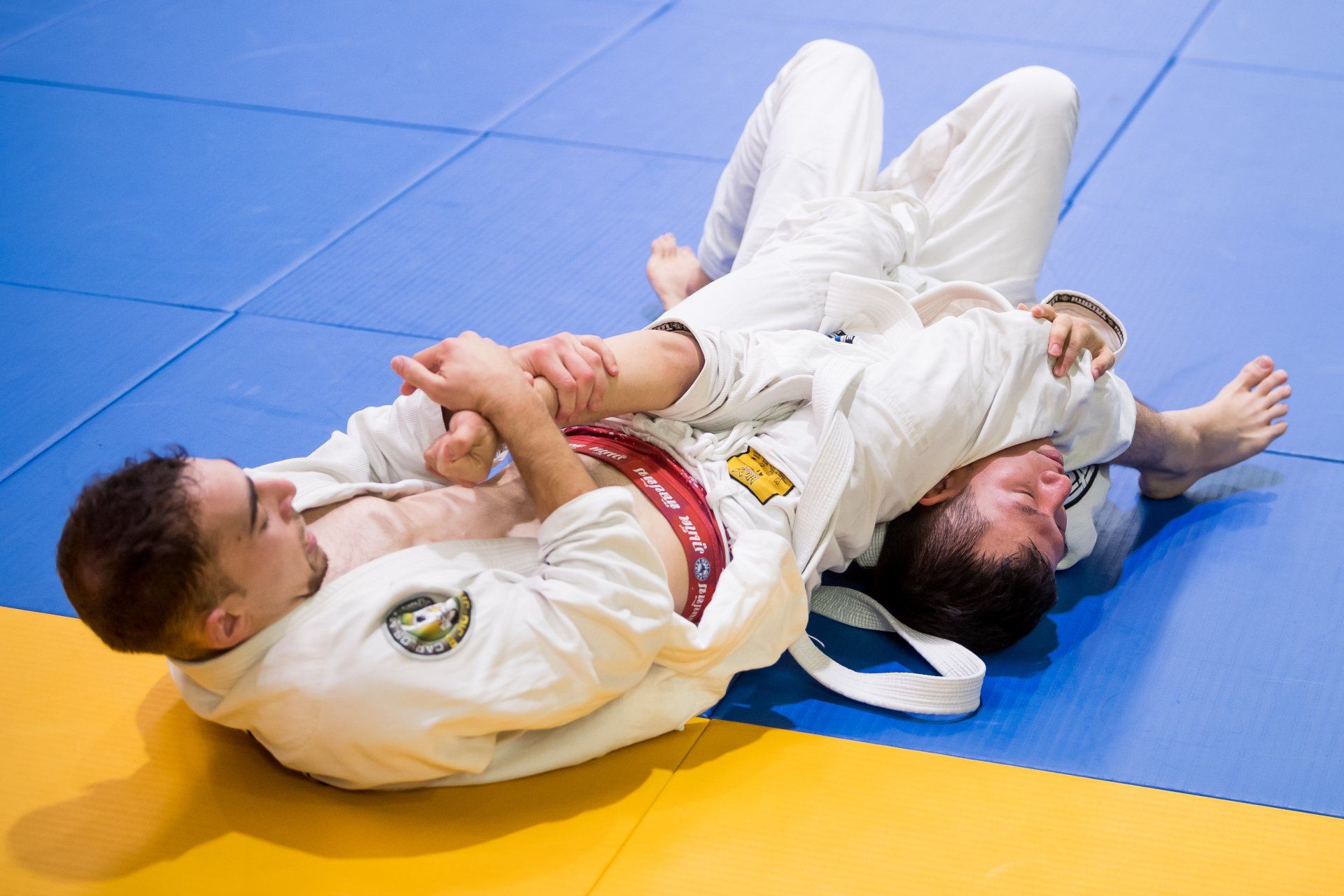
Learn about BJJ
What is Brazilian Jiu Jitsu
Learn about the Art the revolutionised Combat Sports
To find out about Brazilian Jiu Jitsu (BJJ) at Kings Academy click here: BJJ at Kings
Brazilian Jiu Jitsu (BJJ) gained fame as a martial art thanks to the UFC (Ultimate Fighting Championships) where a skinny Brazilian Fighter, Royce Gracie, was able to submit and beat much larger opponents to the surprise of all the spectators. Royce’s time in the UFC (along with his brother Rickson fighting in Japan) created the opportunity for many more Brazilian Jiu Jitsu fighters to continue to build the reputation of BJJ as a dynamic, effective, and practical Martial Art. We find plenty of BJJ practitioners around the world from all genders, races, ages, and backgrounds including Chief Instructor Elvis Sinosic who was a Pioneer of both BJJ and MMA for Australia. Above all, Brazilian jiu-jitsu has numerous benefits beyond the ability to fight or defend oneself. It is for sure that training BJJ (jiujitsu) has changed the lives for better of numerous people around the world (providing improved physical and mental health, stress-busting, awesome body transformation, increased confidence, discipline, respect, courtesy, and so much more). Let’s have a look at the many different aspects of this amazing Martial Art. Let’s start by learning the history of this effective Marital Art.
Before Brazilian Jiu Jitsu (BJJ) there was Judo
In 1882, Jigoro Kano, a student of traditional Japanese Jiu-Jitsu, founded a martial arts school that would come to be known as the Kodokan. At the Kodokan, Kano instructed students on what he felt were the most effective techniques of Japanese Jiu-Jitsu. A unique aspect of Kano’s art, which would eventually come to be known as Judo, was its emphasis on live sparring, also known as randori. Through randori, Kano’s students practiced throws, takedowns, joint locks, and chokes against resisting opponents. Judo’s implementation of randori represented a major departure from the prevailing training philosophy of the time, which favoured compliance-based drilling over full-contact sparring.
Approximately 30 years after Judo’s founding, a journey to Brazil by one of Kano’s students would set in motion a chain of events that would eventually lead to the creation of the world’s most effective ground fighting art.
Where did Brazilian Jiu Jitsu (BJJ) come from?
Mitsuo Maeda began training at the Kodokan (Judo) in 1894, eventually becoming one of Jigaro Kano’s top students. While well-versed in throws and takedowns, Maeda’s specialty was ground fighting, known as newaza.
In 1914, Maeda travelled to Brazil, where he befriended a businessman named Gastão Gracie. Maeda would eventually accept Gastão’s son, a teenager name Carlos Gracie, as his student. Carlos studied Maeda’s newaza-based style of judo for several years, eventually sharing his knowledge with his younger brothers.
Carlos Gracie had found that jiu-jitsu was a very efficient martial art, where he could conquer opponents physically stronger. From here starts the promotion of BJJ with the famous saying “a smaller, weaker BJJ practitioner can successfully defeat a much bigger, stronger opponent by using leverage and proper Jiu Jitsu techniques”
Outside of Maeda’s lineage tree, there were other Japanese masters teaching in Brazil at the same time, men who were lesser known, though still relevant to the development of Brazilian grappling, people like Takeo Iano in the North of Brazil and Kazuo Yoshida in Bahia, to name a few
Brazilian Jiu Jitsu (BJJ )historical key moments
1925's: Master Carlos Gracie opened the first jiu-jitsu school named the “Academia Gracie de Jiu Jitsu. “
1990s: the BJJ martial arts makes the buzz in the United States. Subsequently, when Royce Gracie won a fight in the UFC (Ultimate Fighting Championship) against a strong martial arts opponent.
1994s: Carlos Gracie Jr. founded the International Brazilian jiu-jitsu Federation (IBJJF) with the goal of regulating and governing Jiu Jitsu and competitions.
The Importance of Jiu Jitsu in Mixed Martial Arts (MMA)
The first steps of MMA happened in the 1920’s in Brazil and these events were called “Vale Tudo” (anything goes or no-holds-barred). They were unsanctioned bouts with no rules (eye-gouging and strikes to the groin were allowed) no gloves, no weight categories, and most of the time they did not have a time limit either. It was in these bouts that many jiu-jitsu representatives made their mark and created a reputation about the Jiu Jtisu style. As the sport progressed, a few tweaks were made to these Vale Tudo matches, but nowhere near what the sport is today.
In the early days, when these matches started occurring, Jiu Jitsu’s greatest opponent was Luta Livre, a style of submission grappling used in Brazil. As the popularity of Vale Tudo grew, so did the rivalry between these two opposing styles, so much that many street fights between students of both martial arts and even Dojo storming were common practice.
In 1984 an attempt to settle the affair was made with the “Jiu-Jitsu vs Martial Arts” event being held where several important figures of Jiu-Jitsu were put up against fighters of other trades (but mainly Luta Livre). The result was inconclusive, and the unfriendly Banta continued, until 1991, one of the most important events in the history of Vale Tudo/MMA was held to decide once and for all which was the best martial art in Brazil, the name of the event was “Desafio – Jiu-Jitsu vs. Luta Livre” (BJJ vs Luta Livre Challenge). 3 fighters were chosen from each style to compete against each other in a Vale-Tudo match with no time limits, the fighters from BJJ were Wallid Ismail, Murilo Bustamante and Fabio Gurgel against Eugenio Tadeu, Marcelo Mendes, and Denilson Maia from Luta Livre. Jiu-Jitsu won all three fights, a major feather on the cap of BJJ’s community who became broadly considered the stronger style, the dispute between the two styles had many ups and downs, and that dispute ultimately led to the ban of Vale Tudo in Brazil.
While the Brazilian Vale Tudo panorama was roaring, the same was not happening in the United States. It was again through the Gracie family’s efforts that the sport was put in its rightful place. The Gracie’s had seen a market for their Jiu-Jitsu style in America after opening an academy in California. In trying to prove that their style was the superior martial art available, the Gracie’s developed a No Holds Barred event, the concept being designed by Rorion Gracie. This event was named Ultimate Fighting Championship (UFC), and it had the same principle as the Vale Tudo events back in Brazil. The first champion to emerge from this event was the aforementioned Royce Gracie, who later became a UFC Hall of Fame inductee.
The UFC event itself would suffer severe changes to the initial rule-set in an push to become a legitimate sport, such as the inclusion of gloves, the kimono (Gi) being stripped, the time limit (rounds) being added, striking limitations added, etc. With time the fighters became more well-rounded learning all facets of the game. Today, though less relevant than it was in the past, Jiu-Jitsu is still one of the most important disciplines in the sport.
As NHB started in the US during the early 1990s, the same took place in Japan around the same time. Considered the birth nation of Martial Arts, Japan would have a head start when it came to No Holds Barred; the Japanese were serious about striking martial arts and ground fighting with their Karate and Kosen Judo schools. Still, when MMA (Vale Tudo) emerged in Japan, another Gracie name rose above all others, the name of Rickson Gracie. Considered by many the greatest BJJ competitor of all time, Rickson remained undefeated throughout his career, and once again cemented the Gracie name and the Jiu-Jitsu style in that country and around the world.
What is Jiu Jitsu?
The word “jiu jitsu” derives from the Japanese “Jū” meaning “gentle” and “Jutsu” meaning “art”; essentially, jiu jitsu is the “gentle art”.
Brazilian Jiu-Jitsu (BJJ) is a grappling focussed martial art whose central theme is the skill of controlling a resisting opponent in ways that force them to submit. Due to control generally being easier on the ground than in a standing position, much of the techniques of Brazilian Jiu-Jitsu (BJJ) are centred around the skill of taking an opponent to the ground and wrestling for dominant control positions from where the opponent can be rendered harmless and forced to surrender.
To control and overcome greater size, strength, and aggression with lesser size and strength is the keynote of the sport of Jiu Jitsu. This is done by utilizing superior leverage, grip, and position upon your opponent. Students of the sport gain a deep understanding of the workings and limits of the human body.
Brazilian Jiu Jitsu (BJJ) as a martial art for ground fighting
Brazilian Jiu Jitsu focuses extensively on grappling and mostly takes place on the ground. BJJ practitioners use chokes, strangles and joint locks to submit their opponents, mostly from a sports perspective. Traditional BJJ also covers self defence moves which may incorporate strikes such as punching and kicking.
Brazilian Jiu-Jitsu (BJJ) Gi and No-Gi Grappling
There are two styles of the Brazilian jiu jitsu:
Jiu jitsu Gi: the BJJ practitioner wears a uniform (kimono).
Jiu jitsu No-Gi: is like a grappling discipline, where the fighter wears a rash guard and shorts.
Brazilian Jiu-Jitsu (BJJ) Benefits
Brazilian Jiu Jitsu students enjoy practicing this beautiful martial art. BJJ has plenty of benefits to offer the student practitioner such as:
- Greatly increased fitness.
- Improved health and well-being.
- Increased problem-solving ability.
- Self-knowledge of the physical and mental for the individual.
- Combat effective Martial Art.
- (Many Law Enforcement and Military personnel now practice BJJ)
- Social benefits of working within a group of like-minded individuals.
- Etc
Brazilian jiu-jitsu (BJJ) belts the IBJJF Graduation System
The graduation of athletes must meet the following age requirements for each belt (details on each belt level will follow)
Athletes between 04 to 15 years old
White Belt: Any age.
Group Grey (Grey and White Belt, Grey Belt, Grey and Black Belt): Ages 4 to 15 years old.
Group Yellow (Yellow and White Belt, Yellow Belt, Yellow and Black Belt): Ages 7 to 15 years old.
Group Orange (Orange and White Belt, Orange Belt, Orange and Black Belt): Ages 10 to 15 years old.
Group Green (Green and White Belt, Green Belt, Green and Black Belt): Ages 13 to 15 years old.
Athletes from 16 years old:
White Belt: Any age.
Blue Belt: 16 years old or older
Purple Belt: 16 years old or older.
Brown Belt: 18 years old or older.
Black Belt: 19 years old or older.
Red and Black Belt: 50 years old or older.
Red and White Belt: 57 years old or older.
Red Belt: 67 years old or older.
Brazilian Jiu Jitsu (BJJ) Adults belt ranks
White belt
White belt is the beginning rank for all Brazilian jiu-jitsu students.
White belt is the first belt within Brazilian jiu-jitsu. The rank is held by any practitioner new to the art and has no prerequisite. Some instructors and other high-level practitioners think that a white belt’s training should emphasize escapes and defensive positioning since a white belt will often fight from inferior positions, especially when training with more experienced practitioners.
Most academies will additionally require that a white belt level practitioner works to obtain a well-rounded skills set, with a knowledge of basic offensive moves, such as common submissions and guard passes.
WHITE BELT GOALS
· Learn how to relax
· Learn the basic positions (guard, side control, mount)
· Master one guard pass, one submission, one sweep
· Work on your conditioning
Blue belt
The IBJJF requires a practitioner remain a blue belt for a minimum of 2 years.
Blue belt is the second adult rank in Brazilian jiu-jitsu. At the blue belt level, students gain a wide breadth of technical knowledge and undertake hundreds of hours of mat-time to learn how to implement these moves efficiently.Blue belt is often the rank at which the student learns a large number of techniques.
The IBJJF requires that a practitioner be at least 16 years old to receive a blue belt, thereby officially entering into the adult belt system.
BLUE BELT GOALS
· Focus heavily on defense
· Master multiple techniques for passing the guard
· Have multiple escapes from mount, back mount, side control
Purple belt
The IBJJF requires a practitioner remain a purple belt for a minimum of 1.5 years.
Purple belt is the intermediate adult ranking in Brazilian jiu-jitsu. The purple belt level practitioner has gained a large amount of knowledge, and purple belts are generally considered qualified to instruct lower-ranked students. In other martial arts, students with a similar amount of experience are often ranked as a black (instructor) level belt.
The IBJJF requires student to be at least 16 years old and recommends they have spent a minimum of two years ranked as a blue belt to be eligible for a purple belt, with slightly different requirements for those graduating directly from the youth belts.
PURPLE BELT GOALS
· Have a dangerous guard game
· Can execute multiple combination attacks
· Comfortable using and passing advanced guard variants (de la riva, spider, deep-half, etc)
· Can execute multiple submissions from all mount positions
· Leg lock introduction
Brown belt
The IBJJF requires a practitioner remain a brown belt for a minimum of 1 year.
Aside from the exceptional belts awarded at the highest levels, brown belt is the highest ranking color belt in Brazilian jiu-jitsu. Brown belt typically requires at least five years of dedicated training to achieve. It is often thought of as a time for refining techniques.
The IBJJF requires that students be at least 18 years old and recommends they have spent a minimum of 18 months as a purple belt to be eligible for a brown belt.
BROWN BELT GOALS
· Craft your own style
· Transition your mindset from defense first to attack first
· Becomes comfortable using leg locks
· Comfortable with several advanced techniques
Black belt
The IBJJF requires a practitioner remain a black belt for a minimum of 31 years.
As with many other martial arts, the black belt is the highest common belt within Brazilian jiu-jitsu, denoting an expert level of technical and practical skill. Estimates of the time required to achieve the rank vary, but all holders of this rank have thousands of hours of experience. Brazilian jiu-jitsu black belts are often addressed within the art as professor, although some schools and organizations reserve this honorific for more senior black belts.
The IBJJF requires that a student be at least 19 years old and recommends they have spent a minimum of 1 year ranked as a brown belt to be eligible for a black belt.BJJ red Belts or coral belts
· 1st to 3rd Degree Black Belt – After receiving the initial black belt, a practitioner must hold that rank for 3 years before earning their 1st degree, and another 3 years after that to earn their 2nd degree then another 3 years for their 3rd degree. It is generally standard that, in order to earn degrees past your initial black belt, that you be involved with the teaching of Jiu-Jitsu rather than simply competing. At 3rd degree a Professor can now present a Black belt to their students.
· 4th to 6th Degree – Once a Jiu-Jitsu practitioner receives their 3rd degree black belt, the time between degrees increases from 3 to 5 years. It remains this way from 4th degree to 6th degree. When this happens, the practitioner must wait 7 years before getting their next degree.
BLACK BELT GOALS
· Know that the journey never ends
· Continue to learn and grow
· Consider cross-training in other arts
· Focus on keeping your body and mind in shape
Coral Belt and above
· Red and Black Belt (Coral Belt)
· Red and White Belt (Coral Belt)
· Red Belt
There are other belts in Brazilian jiu jitsu higher ranked than the black belt such as Red / Black belt, Red / White belt, and the Red belt.
Once obtaining a coral belt, the practitioner has shown that they are as close to a master of the art of jiu jitsu as one can possibly be. Although no one will ever know every variation of every technique, a red belt has dedicated their entire life to the sport and should be revered as such.
By the time a practitioner receives their red belt, their focus should be less on their own personal progression and more on helping others or the community as a whole. It’s the highest honour available in the jiu jitsu belt progression, and thus comes with the most respect and the most responsibility.
· 7th and 8th Grade (Coral Belts) – BJJ coral belts are the next step after the 6th degree black belt. The 7th degree coral belts are an alternating pattern of black and red stripes instead of being solid all the way through. A practitioner must hold this rank for another 7 years before receiving their 8th degree. For their 8th degree, they are awarded a red and white patterned coral belt similar to that of judo.
· 9th and 10th Grade (Red Belt) – The red belt in BJJ, or 9th degree black belt, is the highest honour one can achieve in the sport. Renzo and Royler Gracie said that the red belt is reserved “for those whose influence and fame takes them to the pinnacle of art.” One must hold their 8th degree belt for 10 years before being eligible for the red belt. This essentially means that, to get a red belt, you would have to be a practicing black belt for 48 years. 10th degree belts also exist but were only given to the original pioneers of Brazilian Jiu-Jitsu, none of whom are still alive today. Red belts are generally referred to as “grandmasters.”
Brazilian Jiu Jitsu (BJJ) Youth Belt Ranks
Children’s Jiu Jitsu between 4 and 15 years old can receive belt colours that reward progress after a white belt but before earning a blue belt. Which may only be awarded to people 16 years or older.
International Brazilian Jiu-Jitsu Federation specified 13 belts for competitors aged 4 through 15 years old.
White, Gray-White, Gray, Gray-Black, Yellow-White, Yellow, Yellow-Black, Orange-White, Orange, Orange-Black, Green-White, Green, Green-Black.
IBJJF suggests 3 (three) methods of dividing each belt in degrees for practitioners aged 04 to 15 years old. Adoption of any of the following methods is at the discretion of each professor.
Quarterly System (every 3 months)
This is the system used by Kings Academy
For academies that adopt the graduation system of every three months, IBJJF suggests three degrees for each belt.
The Fourth Degree will graduate the athlete to the next belt colour.
Triannual System (every 4 months)
For academies that adopt the graduation system of every four months, IBJJF suggests two degrees for each belt.
The Third Degree will graduate the athlete to the next belt colour.
Monthly System (every month)
For academies that adopt the graduation system of every month, IBJJF suggests 11 degrees for each belt. The 12th Degree will graduate the athlete to the next belt colour. The first four degrees are white, the next four are red and the last three are the colour of the next belt;
Brazilian Jiu Jitsu (BJJ) Submissions
There are dozens of Brazilian jiu jitsu submissions. And all lead a BJJ opponent to tap out. Here are some BJJ submissions:
Armbar - The armbar is an excellent submission that can be applied in both sport BJJ and MMA. The basic mechanics of the armbar is you isolate and hyperextend the arm beyond its range of motion by using your legs, hips, and arms. The opponent taps out or risks having their arm broken through hyperextension.
Triangle choke - The triangle choke is the quintessential submission of BJJ. It is perhaps the best technique to demonstrate how a solid understanding of leverage can overcome size and strength. What makes the triangle choke especially dangerous is its versatility. The Triangle coke is where you wrap your legs around the neck and one arm of your opponent. You legs for a triangle shape (where the name comes from). The Triangle choke is applied by squeezing your legs and pulling down on your opponent’s head until they tap or pass out. Royce Gracie made the Triangle choke famous when he submitted Dan Severn in the UFC.
Kimura - The kimura is a bent joint lock that used rotational pressure on the shoulder joint. The Kimura can be applied from almost any position. What makes the kimura a high percentage technique is its versatility. You can attack a kimura whenever you see the opponent overextend or post their arms on the mat. This is especially easy when they are inside your guard. Aside from its finishing potential, you can also use the kimura to work on sweeps and transitions to other positions such as the back. The Kimura trap system has become very popular in recent years.
The Guillotine choke – The Guillotine choke is probably the most well-known and easiest to apply submission in BJJ. The guillotine choke is a technique where you use your arm to loop around the opponent’s neck and squeeze until they tap or pass out. It is a versatile submission usually applied from the guard position. It can be captured once your opponent turtles up and you end up in the front headlock position. There are many variations of the guillotine choke. The Guillotine choke has been used to defend against the wrestling double leg and became very popular in MMA competition.
Rear Naked Choke (Back Choke) - The rear naked choke (RNC) is the highest percentage move you can do once you get the back. It is a technique where you wrap your arm around your opponent’s neck to restrict air and blood flow by squeezing your arms until your opponent taps or passes out. The Rear Naked Choke is considered the ultimate submission as it disables your opponent and causes the least amount of damage to them and puts the attacker in the least amount of danger. It was the most common finish in the early days of Jiu Jitsu when fighting in the Vale Tudo events.
Heel Hook - The heel hook is by far the strongest leg submission you can do in all of grappling. The Heel Hook is a rotational leg lock uses the heel of the foot to apply rotational pressure to the knew. It is a technique that can undoubtedly cause damage if not addressed appropriately. It is, therefore, important to study and be mindful of its nuances. Chief Instructor Elvis Sinosic was the first person in ADCC competition history to win with a Heel Hook submission at the ADCC Submission Wrestling World Championships.
Brazilian Jiu Jitsu (BJJ) Basic Positions
The full guard
A BJJ practitioner takes the full guard if their legs are closed around the waist of their opponent with the ankles crossed. This is the first guard a BJJ practitioner will learn. It is the basis for self defence in BJJ as it offers the best combination of protection and offence.
The half-guard
A jiu jitsu practitioner has a half-guard when they have one legged trapped of their opponents. There are several different half-guard variations including Z-guard, Deep half-guard, Butterfly half-guard to name a few.
The Open guard
A jiu jitsu practitioner has open guard when their legs are uncrossed, and they control their opponent with various foot positions and hand controls. There are many different types of Open guards and here are a few of them, Butterfly Guard. De La Riva Guard, X-Guard, Single X-Guard, and K-Guard here are few guards that are for the Gi only, Collar and Sleeve Guard, Lapel Guard, Worm Guard, etc.
Side control
A BJJ student will get to side control position when they pass their opponents guard (clear the hips and legs), and they control from the side of the body, and their body is perpendicular to their opponent. There are various arm positions such as cross-face, cross body, etc. They are all variations of the side control position with chest to chest contact being the most common position.
Mount position
The mount position is where the practitioner will sit on the belly or chest of their opponent together with their legs at the edges of the opponent’s body. The position is also considered mount if you have one of your opponent’s arms trapped underneath you but not if both arms are trapped underneath.
Back control
Back control is where a BJJ player is behind their opponent controlling them with their arms and legs from behind. It’s one of the most dominant positions in Brazilian jiu jitsu and the preferred position to achieve in self-defence. In BJJ competition you must have hooks (feet on the hips but not crossed) and upper body control to be considered back control to score points. There are other positions such as the body-triangle and hip-lock positions, but they do not score points in IBJJ F events even though they can sometimes provide better control. In many submission grappling competitions these back control positions will score points.
Knee-ride or Knee on Belly
The Knee-ride also known as the knee on belly is where the BJJ Player has their knee on the stomach or chest of their opponent controlling the upper body usually with a collar and sleeve or cross face grip facing towards the head of the opponent. If you have the knee-ride position but are facing the legs, there are no points scored in most competitions.
Turtle Position
The Turtle position is where the opponent is on their hands and knees an the BJJ practitioner is on the side (side back control) or the front (front head lock position). Generally, in most competitions there are no points for achieving this position. The Turtle position is used to defend for the person on the bottom and used by the person on top to try and get the back control position.
Brazilian Jiu-Jitsu (BJJ) Competition
Another important reason why Jiu-Jitsu has grown so fast since the 1990s has been the competition side that has been regulated by a governing body (IBJJF), there are different organizations spread thought the world with slightly different rules, though these (on this list) are broadly considered the biggest ones on the Jiu Jitsu/Grappling calendar.
The IBJJF World Jiu-Jitsu Championships (Mundial): The biggest tournament in the world has been running steadily since 1996, run by CBJJ/IBJJF. The Mundial is for ranks from Blue Belt to Black belt and is for 18-30 year old’s (though older competitors can compete in this event).
IBJJF Masters Worlds: This is the World Championships for the Masters divisions, 30yrs and older. IBJJF Masters Worlds is the larges of the World Championships with the most competitors. Masters Worlds only has belts from Blue Belt and above. Here are the Age divisions for Masters:
Master 1: 30 to 35 years old
Master 2: 36 to 40 years old
Master 3: 41 to 45 years old
Master 4: 46 to 50 years old
Master 5: 51 to 55 years old
Master 6: 56 years old and older.
IBJJF NoGi Worlds: The IBJJF NoGi Worlds are the NoGi equivalent of the Mundials.
The Pan Jiu-Jitsu Championship (Pan Ams: The second most important tournament in the IBJJF calendar (outside of the World Championships), has grown from strength to strength. There are also the Pan-Pacific and Pan-Kids Championships which are smaller events. The Pan Jiu Jitsu Championships are gaining exposure for their high level of competition and they have also produced World Champions over the years.
World Professional Jiu-Jitsu Championship (World Pro Cup): One of the newest competitions to be added to the curriculum, this UAE based tournament gathers the top competitors in the world through a series of trials held in most continents. It also has the advantage of awarding a large prize money to it’s contestants.
Brasileiro de Jiu-Jitsu (Brazilian National Championship): One of the oldest and the most prestigious competition still held in Brazilian soil. The “Brasileiro” is a big opportunity for some of jiu jitsu’s elite to showcase their skills, especially those that cannot get a visa to enter the USA where the Mundials are held.
European Open Championship: The best chance European “Jiujiteiros” have to showcase their skills to the broader public, this event is held in Lisbon, Portugal every year in January and it marks the opening of the CBJJ/IBJJF calendar for the year.
UAEJJF GRAND SLAM (UAEJJF): Established in November 2012, the UAEJJF is the official authority for Jiu-Jitsu in the United Arab Emirates. The Federation has implemented policies to help develop the sport of Brazilian Jiu-Jitsu in partnership with various government entities and educational organizations. The UAEJJF holds multiple events per year that feature both amateur and professional grapplers from around the globe. Athletes can earn points at regional qualifying events to win travel and accommodation packages for the Abu Dhabi World Pro.
Abu Dhabi Combat Club (ADCC) Submission Wrestling World Championships: Not made specifically for Jiu Jitsu, it is the largest and most prestigious submission grappling event on the planet held every two years. BJJ practitioners have been the most successful style within the ADCC rule set. Entry to the ADCC Championships is done by winning the Trial events held around the world or by invitation (usually by winning or placing in previous years events). The ADCC Championships is considered the World Championships of the No-GI or Submission Grappling community, holding higher prestige than the IBJJF No Gi Worlds. It holds the same prestige as a Mundial World Championship does for the Gi. The winner of the ADCC Championships is considered the best NoGi grappler on the planet.
Professional BJJ/Grappling Competitions: Outside of the ADCC Submission Wrestling World Championships there are also many other Professional Grappling events gaining critical acclaim and exposure. Some of the better known events over the years are the Eddie Bravo Invitational (EBI), Fight 2 Win, Submission Underground, Polaris Pro Invitational, and the Kasai Pro. These are events are generally considered Superfight events though some do have mini tournaments. The athletes in these events are paid to compete and fight to win prize money which is different to the amateur events where competitors pay to compete.
The Brazilian Jiu Jitsu (BJJ)/Submission Grappling Rules:
The rules of Brazilian Jiu Jitsu are not simple; in fact, refereeing has been a touchy subject because of this over the years. In order to leave the sports essence intact while trying to protect its competitors from serious risk there have been many unconventional rules added to the rule’s manual over the years. Different tournaments also may apply different rules (as we see happening with the World Pro Cup and the ADCC). The basic concept behind the rules of Jiu Jitsu is, if you advance/improve your positioning you get awarded points, if you force your opponent to tap (give up) due to a choke or joint lock pressure you immediately win the contest. If you attempt to advance a position or perform a submission but are unsuccessful you are awarded an advantage. If you do something illegal, you are given a penalty (penalties can also award points to your opponent as they are accrued). A severe or intentional penalty will get you disqualified from the match and in a competition you will not receive a medal even if you would have placed.
The Main Points Are (IBJJF):
“Queda” – Throw or Takedown: If both challengers are standing, and one initiates and succeeds at taking the other to the mat, he is awarded 2 points.
“Raspada/Raspagem” – Sweep: If your opponent is within your guard (any kind of guard) and you invert the position (with you landing on top and your opponent on the bottom) you are awarded two points if you can hold the position.
“Passagem de Guarda” – Guard Pass: If you are inside your opponent’s guard and manage to escape that position, still maintaining top position, you have improved your position and therefore are awarded 3 points. The exception is if you pass the guard, but your opponent goes to the Turtle position, then you are awarded an advantage.
“Pegada de Costas” – Back Control: Regardless of where you are, if you manage to take your opponent’s back and place both feet around the inside of your opponent thighs (hooks), controlling him that way, you are awarded 4 points (you will need to place the hooks, body triangle will not score points in IBJJF rules).
“Montada” – Mount: On top position with both legs around the opponent’s torso with knees on the ground, 4 points. You can trap one arm under your legs while on mount and receive a score but cannot have both arms trapped under your legs. The person on the bottom can be on their back (mount) on their side (side mount) or on their stomach (back mount). Back mount is different to Back Control as there are no hooks. All these mount positions will score in competition.
The duration of bouts are:
Adult White belt division are 5 minutes.
Adult Blue belt division are 6 minutes.
Adult Purple belt division are 7 minutes.
Adult Brown belt division are 8 minutes.
Adult Black belt division are 10 minutes.
Masters’ divisions are 5 minutes.
Junior and Juvenile divisions are from 2 to 5 minutes.
The opponent with the most points at the end wins the fight if there is no submission.
Important Figures in Brazilian Jiu Jitsu’s (BJJ's) History
Jiu Jitsu has not lacked charismatic and meaningful people in its history, here is a snapshot of some important figures in chronological order:
Carlos Gracie: The founder of Gracie Jiu-Jitsu, Carlos was the visionary behind the movement that became the sport of Brazilian Jiu-Jitsu. Carlos opened the first Gracie Jiu-Jitsu school and taught Jiu-Jitsu to all his brothers.
George Gracie: The Gracie family’s first champion, George fought in several different styles (Jiu-Jitsu – with kimono), Luta Livre (submission grappling), Wrestling, and Vale Tudo (no holds barred). He fought for over two decades but broke free from Carlos and Helio’s team and even competed against them at the end of his career.
Helio Gracie: had his first no holds barred fight in 1932 when he was 18 years old – a win by choke within a minute. Helio placed his career on hold for 12 years, starting in 1938, during his physical prime due to personal reasons. He returned to run the Gracie school and also to compete, having two of his toughest career defeats in this second career turn (Santana and Kimura), but also one of his proudest wins (against Kato).
Pedro Hemeterio: One of Carlos Gracie’s most prolific students, the man from the Ceará region of Brazil fought and defeated numerous competitors in the name of Gracie Jiu-Jitsu. He would also help develop the sport in the state of Sao Paulo in the 1950s.
Carlson Gracie: The son of Carlos Gracie was indeed one of the sports’ greatest icons both competitively and as a coach. He raised the bar of Jiu-Jitsu competing for several decades, while being a visionary coach. Carlson was the first Gracie instructor to have group classes rather then the one-on-one style of coaching utilized by his predecessors, and his team would become one of the strongest in both MMA and BJJ in the 1970s, 1980s, and 1990s.
Oswaldo Fadda: Was one of the first coaches outside Rio de Janeiro’s “Zona Sul” (wealthy area) leaving behind one of the strongest non-Gracie Jiu-Jitsu lineages in the country with links in teams such as Nova Uniao, GF Team, and many others.
Osvaldo Alves: He had a strong Judo pedigree which helped raise awareness of this aspect of grappling amongst the Gracies. His technical knowledge was of great importance, and his close contact with Reyson and Rolls Gracie in the 60s and 70s would help further develop the sport towards a more encompassing grappling style. He has also taught several BJJ world champions.
Ivan Gomes: One of the first “Vale Tudo” men to cross-train in different martial arts, Ivan was a fierce competitor that helped elevate the Jiu-Jitsu name in NHB. He was considered Carlson Gracie’s toughest opponent by Carlson himself. The two would open a BJJ academy together years after their clash.
Rolls Gracie: The big name of the decade and one of the biggest names in the sport, period. His ideas on cross-training in Judo, Wrestling, and Sambo were visionary at the time, and they helped set the pace of the sport in the right direction while also developing it technically. He was a tremendous competitor and the family’s champion during the 70s.
Rolls’ lineage has left its mark and is one of the strongest in the world with Alliance, Gracie Barra, Checkmat, Atos, and Brasa all spawning from his students. The Gracie’s death came very prematurely and his relevance could have been even bigger if he had lived until old age.
Carlos Gracie Junior: After the death of Rolls Gracie, Carlinhos took the helm of his academy; he would later launch a Gracie Academy in what were the outskirts of Rio de Janeiro (today a famous and trendy neighbourhood of Barra da Tijuca). This team would become one of the juggernauts of BJJ from the 1990s onwards. Carlos Gracie Jr also became the president of Jiu Jitsu’s federation and really put Jiu Jitsu’s name on the map at an international level.
Rickson Gracie: The Gracie family stud in the 1980s and for the most of the 1990s, Rickson is famed for his invincible record. After the death of Rolls Gracie left a big hole in the family and the sport, Rickson was of tremendous influence, keeping the flame alive while bringing the sport’s awareness in other parts of the world such as Japan and the United States.
Marcelo Behring: The legendary Rickson Gracie disciple was a tremendous student of the game, being considered throughout his career as the #2 ranked fighter in Brazil (pound for pound), second only to Rickson Gracie. Though his death was a tragedy to the sport, his legacy lived on and the wealth of knowledge he brought to Sao Paulo helped develop the sport in that region (which is today arguably the strongest in the world when it comes to BJJ).
Ricardo De La Riva: A creator and developer of positions, De La Riva was one of the strongest competitors of his generation who heavily contributed to the technical development of BJJ. The De La Riva guard is named after Ricardo and one of the most popular guards in today's competition.
Fabio Gurgel: The leader of the Alliance team was one of the strongest competitors of his generation; he was also of great importance to BJJ with his win over Denilson Maia at the Jiu-Jitsu vs Luta Livre challenge. In the 1990s Gurgel was a fierce competitor, defender of Jiu Jitsu’s honour in NHB as well as a founding member of one of BJJ’s most important schools, Alliance. Some well known students of Fabio Gurgel are Cobrinha, the Langhi brothers, Lepri, Faria, Gabi and Marcelo Garcia, Peinaldo amongst many others. Fabio Gurgel excelled as a coach with over 50 World Champions under his tutelage.
Main Competitive Achievements:
- 4x World Champion (1996, 1997, 2000, 2001)
- 3x European Champion (2007 and 2009 in senior 1 Division, 2010 in Adult Division)
- Brazilian National Champion (1996)
Royler Gracie: Already an important figure of Jiu-Jitsu in the 1980s, Royler was one of the best Gracie champions ever produced at the sport of BJJ, setting the record for World Championships and ADCC gold medals during his heyday. Royler was the first king of the featherweight division and the first truly dominant BJJ’er in the new CBJJ/IBJJF era.
Royce Gracie: Royce probably brought more awareness to Jiu-Jitsu then anyone on the planet. His wins at the early UFC’s put Jiu-Jitsu on the cover of most martial arts magazines in the world.
Wallid Ismail: The Carlson Gracie champion made headlines numerous times throughout the decade. His wins over Gracie family members Ralph, Renzo, and Royce helped put his name and the name of his academy on the map, but it was his back and forth antics with Ryan Gracie really kept the press working overtime. Wallid was also one of Carlson Gracie’s most loyal students.
Roberto Correa/ Nino Schembri / Roberto Magalhaes: 3 very important figures for Jiu-Jitsu all from the Gracie Barra academy, all 3 were world champions; however it is in the development of the technical aspect of the sport that they will always be remembered. Correa is regarded as the father of the half guard, having helped develop that position tremendously. Schembri also developed several important positions from the guard and will always be remembered as one of the sports most creative fighters, while “Roleta” Magalhaes developed the inverted guard (today also called tornado guard), another important position that came as a true puzzle when it was first introduced in the competition circuit.
Tererê: The first major star in sport Jiu-Jitsu born in the favelas (Brazilian slums), Fernando was the embodiment of class struggle in Brazil. The flamboyant black belt under Alexandre Paiva was one of the biggest stars at the turn of the millennium, using a very innovative and athletic style, which set the gears in motion for modern-day jiu-jitsu.
Saulo Ribeiro /Xande Ribeiro: The Ribeiro brothers together have 11 world BJJ gold medals and 4 ADCC first spots; they have competed and won against the best fighters of their generation. They have also developed a fair share of interesting black belt talent through their academy in California.
Marcelo Garcia: A BJJ phenomenon, this multiple-time world champion in Jiu-Jitsu has proven his worth numerous times with and without the gi. His charisma has also gathered a legion of fans around him, and he is regarded as one of the most talented fighters to have ever competed in BJJ. Marcelo was famous for his amazing arm drag and back takes. Though he was talented at many submissions, the rear naked choke will always be what he is best remembered for. In his day he was the giant killer of BJJ.
Ronaldo Souza: Anther amazing competitor that came from the city of Manaus (like the Ribeiro Bros), “Jacare” as he is known annihilated his opposition before turning to MMA.
Roger Gracie: There is only one Roger Gracie and in BJJ there are no adjectives that can quantify this man’s greatness within the sport. The number of titles could speak for themselves, but the emphatic fashion with which he managed to pull off his wins is of tremendous significance. If it has been said that there was a time before Rolls Gracie and a time after Rolls Gracie, the same can be said about Roger Gracie.
Carlos Machado: 8th Degree Red & White belt. Oldest of the five brothers. While in Brazil, he successfully competed and was champion for 10 years straight in competition at the State and National level which at the time was equivalent to the Worlds as BJJ had not spread to the masses yet. He competed and won against many of today's top founders of BJJ teams. He believes BJJ is the greatest addition to modern martial arts. Carlos was teaching in America as early as 1990. In April 1994 he moved to Los Angeles, California. There he met martial arts movie star Chuck Norris, who was instrumental in promoting Brazilian Jiu-Jitsu and the Machado family. Since then, Mr. Norris has been one of the greatest advocates of Machado Brazilian Jiu Jitsu. Carlos Machado has been involved in competition, winning the Pan American of Brazilian Jiu Jitsu (97/98), he also won several super fights in the U.S. (U.S Open 98/99), he competed in ADCC with a broken foot and still placed and earned the award of fastest submission in 1998, and the World Master's Championships (2000) in two weight divisions (middle weight and open class). After an impressive 34 year competition career he retired from the competition arena winning the Worlds. He has gained recognition as one of the most accomplished Coaches in the BJJ world.
Carlso Machado is the Coach of Chief Instructor Elvis Sinosic.
Rigan Machado: 8th Degree Red & White Belt. Third oldest of the five brothers. From the age of 14 through 21, Rigan won the Brazilian National Championships every year and in every belt division. While in Brazil, he successfully competed and was champion for 10 years straight in competition at the State and National level which at the time was equivalent to the Worlds. Carlos Machado was awarded the first black belt under Gracie Barra founder Carlos Gracie Jr. and is one of the original teachers who taught in the garage of Rorion Gracie in the early days of Brazilian Jiu Jitsu in America. He also trained with his other cousins such Rickson Gracie, Rorion Gracie, Rillion Gracie, his uncle Carlos Gracie Sr, and his brothers. At one point in 1986, he even publicly competed against Rickson Gracie at a Jiu-Jitsu competition in one of the earliest public matches between members of the family.
He is widely regarded as one of the top competitors in Brazilian Jiu-Jitsu history. He also competed and won many tournaments in judo, sambo, and wrestling to demonstrate the effectiveness of BJJ.
Jean Jacques Machado: 7th Degree Red & Black Belt. Fourth oldest of the five brothers. He held the Rio de Janeiro Jiu-Jitsu State Championships Cruiser Weight Champion and Brazilian jiu-jitsu National. Jean Jacques Machado was born in Rio de Janeiro, Brazil and suffered birth defects resulting from amniotic band syndrome, which left him with only the thumb and the little finger on his left hand. Despite this congenital problem, which directly affects the skill of gripping, he began his Jiu-Jitsu training over thirty years ago and dominated the competitive arena of Brazilian Jiu-Jitsu in his native country, capturing every major title and competition award from 1982 through 1992. He successfully competed and was champion for 10 years straight in competition at the State and National level which at the time was equivalent to the Worlds.
In 1992, Machado arrived in the United States where he continued competing successfully. He then won the following championships: Black Belt Super Challenge Championships 1998 and 2000, Abu Dhabi Submission Wrestling World Championships 1999 - 66–76 kg Division Gold Medalist, Most Technical Fighter Award, 2000 - 66–76 kg Division Silver Medalist, 2001 - Absolute Division Silver Medalist, Best Match Award, Fastest Submission Award, 2005 - Superfight Runner Up.
Leonardo Vieira (Leozinho): Stuck in between two decades (90s and 00s), Leo Vieira was one of the most exciting lightweight/featherweights the sport had the pleasure of celebrating. Similar to Tererê in bringing a more dynamic game to the mats, Vieira is also known as an innovator, using high-level wrestling and a more creative approach to guard-passing, breaking barriers for the passing of the decade that succeeded him. Leozinho would also be the man behind one of the top jiu-jitsu teams in the world, Checkmat, a team he co-founded with his brother Ricardo Vieira.
Rafael Mendes: The Atos standout really made a mark as the most dominant featherweight of his generation, establishing that status at the age of 20. He also developed (alongside his Atos camp) several positions, being the 50-50 guard the most significant.
Rodolfo Vieira: Arguably the most exciting jiu-jitsu athlete of his generation, Vieira brought a superb style with violent takedowns and aggressive guard passing, always with the submission in his sights. Vieira will forever be remembered as one of the finest guard passers with the gi, in this sport, a style he used to bring the GF Team into the spotlight at a global level.
Leandro Lo: the former Cicero Costha student was the first athlete to break Saulo Ribeiro’s record of IBJJF World titles in different weight classes (5) — light, middle, medium-heavy, heavy and open weight, a 20-year-old record Lo broke in 2020.
Marcus Almeida (Buchecha): Much like the aforementioned Roger Gracie, there will be a time before Almeida and after. Buchecha re-wrote the history books by winning 6 IBJJF World Championship open weight titles, bulldozing, and doubling over the previous record set by Roger of 3 open weight titles in the black belt division. Almeida was also one of the most physical grapplers ever seen in the sport, mixing tremendous size with speed and athleticism.
Gordon Ryan: Another “once in a lifetime” grappler, Ryan broke the established convention that, to succeed in the No-Gi, an athlete needed to train with the Gi. Ryan pushed the no-gi envelope tremendously, using his popularity to raise awareness towards the submission-only movement happening in the United States after 2015. Ryan also dominated the ADCC tournament by going “back to basics”, using a classic style of jiu-jitsu, focussed on groundwork when so many athletes were turning towards a more wrestling-centric style to compete in the famous tournament. Gordon Ryan is considered the Greatest No Gi Athlete of all time winning nearly every single Professional No Gi Grappling event around. His highlights are IBJJF NoGi Weight and Absolute Champion, ADCC World Champion in 3 Weight division, 88kg, 99kg and 99+kg divisions, the Absolute division and Superfight division defeating Andre Galvao (who held 6 Championship titles and was considered the greatest ADCC champion prior to his defeat by Gordon).
Conclusion
Brazilian jiu-jitsu is one of the best martial arts everyone should learn. So, when do you plan to start BJJ training?
A Message from the Founder of Brazilian Jiu-Jitsu (BJJ), Carlos Gracie
Jiu-Jitsu constitutes the natural defence the weak person disposes of against the strong person. It is a sort of leveling process through which brute force, confronted and dominated by the wise application of rational mechanics, is led to admitting that the human being, usually taken as a body endowed with a soul, should actually be deemed a soul that happens to reside in a body. This, however, no matter what our philosophical or religious orientation is, must never mean disregard or lack of attention towards the body we use in this world. We don’t understand, really, how, in order to reach wisdom, love, or in order to adore and serve God, respecting His laws, it can be necessary or possible to harm one of His most beautiful and perfect creatures.
If it is true that the disharmony in our thoughts and feelings can generate physical harm, it is no less true that the care we take with our body reflects not only on that body, but also on the mental health we all need to achieve a harmonious, happy life.
Of course, one doesn’t need special abilities to master certain resources of Jiu-Jitsu, which allow us to defend efficiently. Let us not forget, notwithstanding, that, no matter what we look forward to, we will always have better chances of reaching it if we use our greatest spiritual and physical possibilities. Jiu-Jitsu, which cannot escape that peremptory rule, is nothing but its application in self-defence. Being, further, a sport, and indeed one of the most complete, how could it possibly turn its back on physical preparation?
Without health, in its whole meaning, there can be no complete happiness. Very often, however, instead of studying the laws we must respect in order to avoid diseases, we are more concerned about what is the proper medicine or process for repairing the consequences of our ignorance or conscious infractions.
It is illogical for man, who is the most perfect being to inhabit Earth, to have a shorter life than that of other animals. We are among those who fiercely believe we should live more than any irrational being. Therefore, if we compare the current average duration of the human life to that of the parrot’s, we don’t understand why, when one of us decides to live a hundred years, it is something so extraordinary. Imagine if, like an elephant or turtle, one of us happened to live until the age of two hundred!
However, as we see it, all that would be very normal if, throughout generations, with strange perseverance, we hadn’t been driving away from the natural laws.
Among other explanations, for instance, is nutrition. What do we really know about how, when, how much and what to eat in harmony with natural laws?
But let us stop here before, my dear reader, your tolerance goes away completely and you, with justifiable irony, ask: “And, by the way, what about Jiu-Jitsu?”
You are partially right. Due to the fact that it is, however, a difficult – if not impossible – task, in its amplitude, we won’t neglect our duty of warning you that hoping to learn, exclusively by means of reading, the secrets of this traditional art of defense and attack is as efficient as studying singing by mail.
To you, friend and reader, my sincere thanks, and we’ll see each other again. If I didn’t succeed in pleasing you, at least I hope I didn’t totally disappoint you.
~ Carlos Gracie
Founder of Brazilian Jiu-Jitsu
To find out about Brazilian Jiu Jitsu (BJJ) at Kings Academy click here: BJJ at Kings
If you’re interested in doing Brazilian Jiu Jitsu (BJJ) at Kings Academy you can contact us here: Contact Us or you can book a week free trial here: Free Trial
Kings Academy of Martial Arts is the premier Martial Arts Academy Servicing Liverpool and Greater Western Sydney with classes in BJJ (Brazilian Jiu Jitsu), Muay Thai, Boxing, Wrestling and MMA (Mixed Martial Arts).
If you found this article helpful and interesting you can check out:
Why should your child train in BJJ?
Ten Reason to exercise regularly!

